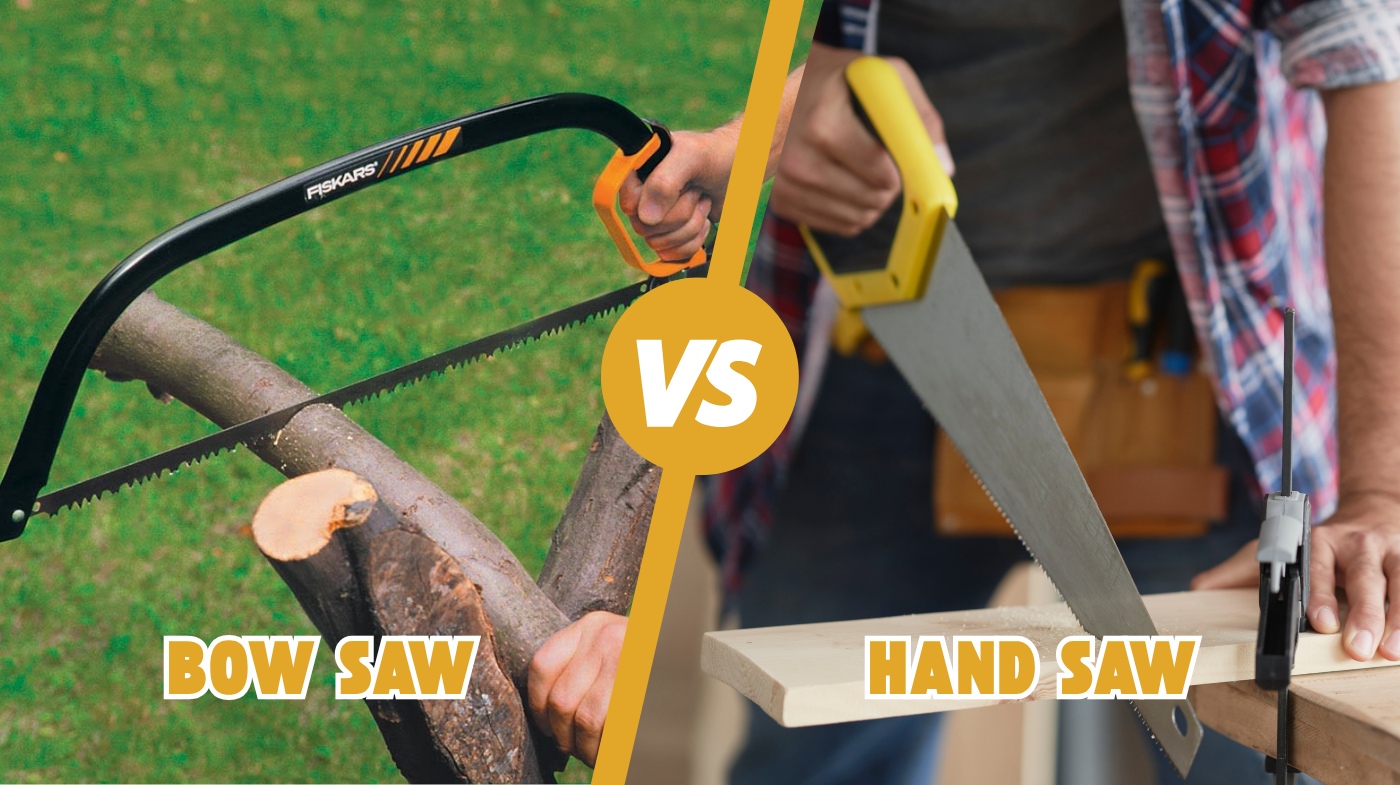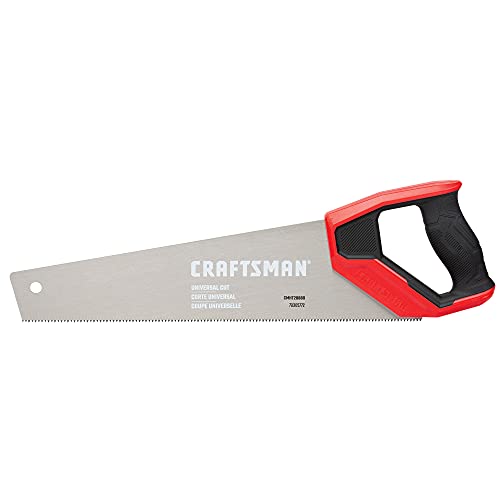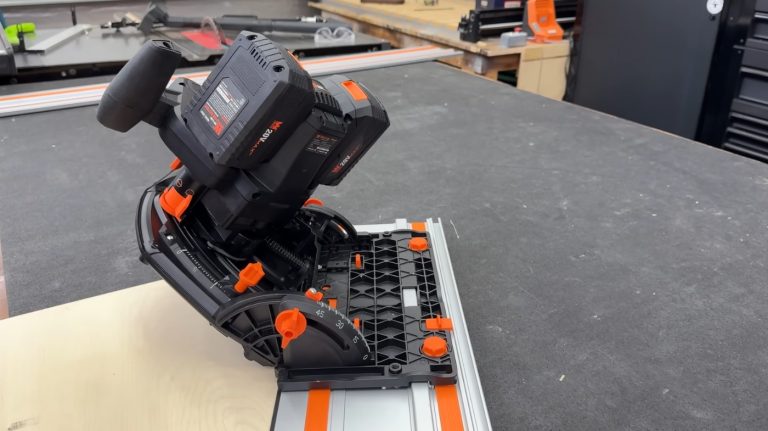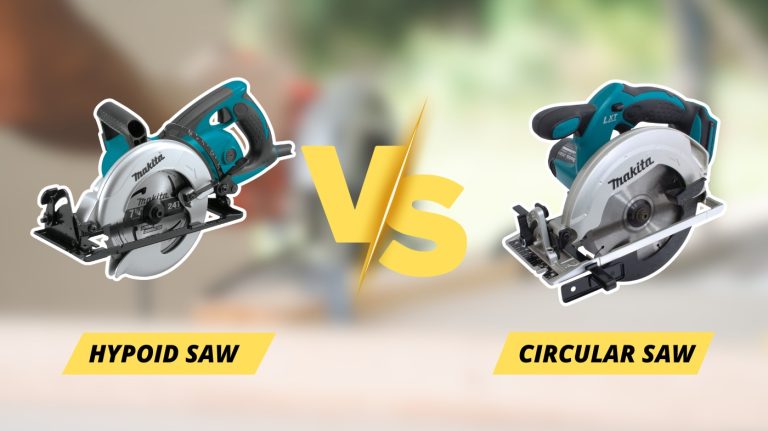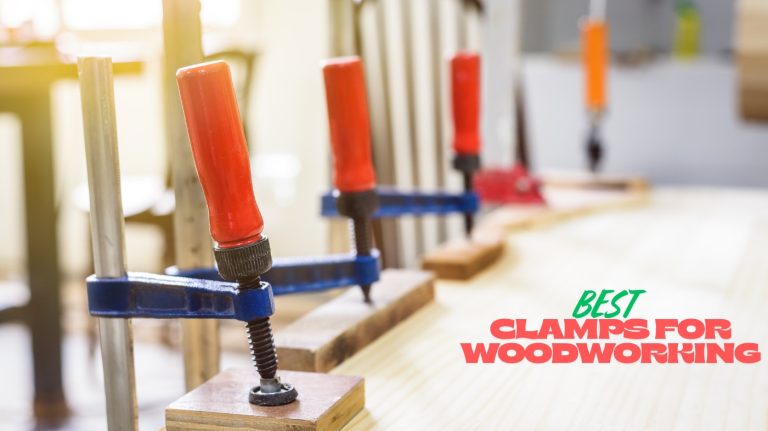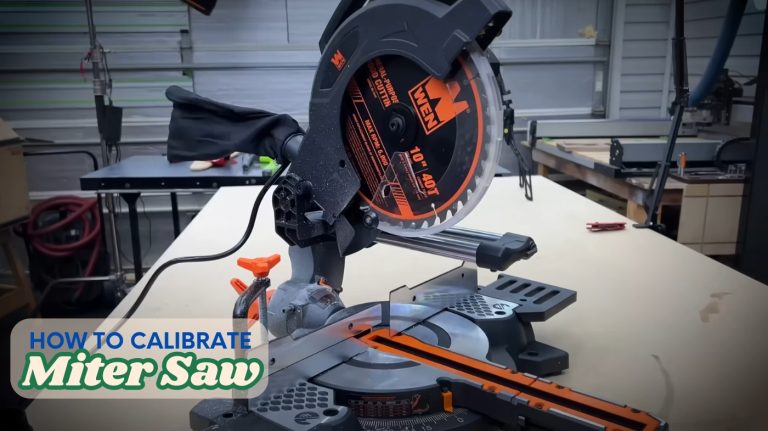Bow Saw vs Hand Saw: Key Differences You Need to Know
If you need fast, rough cuts outdoors on branches or logs, a bow saw’s tensioned, thin blade excels with coarse teeth and two-handed leverage.
For detailed, precise indoor work like joinery, the rigid, thicker blade of a hand saw offers accuracy and control.
Bow saws are bulkier and heavier but ideal for larger tasks; hand saws are lightweight and portable for finer jobs. Understanding their design and use will help you pick the best tool for your project.
- 30 inches long
- Designed to cut through Green wood
- Designed for demanding applications and tough environments of construction sites
- FAST & CLEAN CUTS: The hand saw has an exclusive tooth geometry for a fast clean cut
- DURABILITY: The handsaw features induction hardened teeth for a long lasting sharpness
- COMFORT: Ergonomically designed bi-material handle for comfort and control
Key Takeaways
- Bow saws have a large curved frame with tensioned, flexible blades ideal for fast, rough outdoor cuts on logs and branches.
- Hand saws feature rigid, thicker blades and ergonomic handles designed for precise, controlled indoor woodworking and joinery tasks.
- Bow saws are bulkier and heavier, requiring two-handed use and sheaths for transport, while hand saws are lighter and more portable.
- Bow saw blades use adjustable tension to prevent deflection, enhancing cutting efficiency on thick wood compared to fixed blades in hand saws.
- Hand saws excel in fine, detailed cuts with various tooth designs, whereas bow saws prioritize speed and power for larger, coarse cuts.
Major Differences Between Bow Saw and Hand Saw at a Glance
| Feature | Bow Saw | Hand Saw |
|---|---|---|
| Blade Design | Thin, flexible, tensioned blade in a curved frame | Thick, rigid blade fixed to handle |
| Cutting Speed | Cuts up to 40% faster on rough, outdoor wood | Slower, designed for precise indoor cuts |
| Best Use | Fast, rough cuts on branches and logs outdoors | Detailed, accurate cuts for joinery and fine woodworking |
| Size & Weight | Bulkier, heavier, requires two-handed use | Lightweight, portable, one-handed use |
| Portability | Larger, often requires sheaths or cases | Compact, some folding models available |
| Blade Tension Control | Adjustable tension via screws or levers | No tension mechanism, blade fixed and stiff |
| Cutting Technique | Rhythmic, pull strokes with less wrist strain | Controlled pushing/pulling with blade angle management |
| Durability & Maintenance | Replaceable blades, needs frame care | Requires sharpening, handle care |
| Suitability | Ideal for outdoor, rough, large-volume work | Ideal for indoor, fine, precise work |
Design and Structural Differences
When comparing bow saws and hand saws, you’ll notice that their design and structure directly influence their performance and suitability for different tasks.
Bow saws feature a large, curved frame—often metal or wood—that holds the blade under tension, preventing flex and enhancing cutting accuracy.
This sturdy frame supports longer blades, making bow saws ideal for cutting larger branches or logs. They typically have replaceable blades to extend the tool’s lifespan.
Bow saws have a sturdy, curved frame that keeps blades taut for precise cuts on large branches and logs.
In contrast, hand saws consist of a single blade attached to an ergonomic handle, resulting in a lighter, simpler tool. Without an extensive frame, hand saws rely on blade rigidity and handle grip, which offers less resistance to twisting.
The bow saw’s integrated handle supports two-handed use, delivering leverage and control, while hand saws prioritize one-handed precision for varied, finer cutting tasks.
Blade and Tension Mechanisms
You’ll notice bow saws use thin, flexible blades held under adjustable tension, enabling efficient rough cuts with less effort. These blades typically feature carbide-tipped teeth for durability and cutting precision.
In contrast, hand saws rely on rigid blades fixed firmly to the handle, lacking any tension mechanism to maintain blade straightness. Crosscut saws, a type of hand saw, have teeth filed with a bevel for effective cross-grain cutting.
Blade Design Differences
Although both bow saws and hand saws serve cutting purposes, their blade designs differ considerably due to their tension mechanisms and intended applications.
Bow saw blades are narrow, flexible, and held under tension by a frame, enabling curved and straight cuts. The tooth shape on bow saw blades is chosen based on wood moisture content to optimize cutting performance. This design allows for versatile cuts, making bow saws suitable for diverse woodworking projects requiring precision.
Hand saw blades, on the other hand, are thicker, unframed, and rely on rigidity for straight cuts. Their design emphasizes cutting stability to ensure accurate and consistent results.
Tooth types and sizes vary, affecting cutting speed and finish quality.
- Bow saw blades: 1/8–1/4 inch wide, spring steel, straight or raker teeth for dry or green wood
- Hand saw blades: thicker, solid or taper ground, shaped for rip or crosscut tasks
- Tooth count ranges 3.5–13 TPI; fewer teeth for fast rough cuts, more teeth for fine, slow cuts
Bow saw frames enable blade tensioning; hand saws depend on blade stiffness for precision.
Tension Control Methods
Because maintaining proper blade tension is essential for cutting accuracy and efficiency, bow saws and hand saws employ distinctly different tension control methods tailored to their designs.
Bow saws typically use adjustable screws or cam levers to quickly and precisely tension the blade within the frame, ensuring ideal stiffness to prevent bending during cuts.
Traditional models rely on twisted cords or wires for tensioning, which requires manual adjustment. The blade’s thickness and tension directly influence cutting performance, with thinner blades facilitating delicate cuts and thicker blades suited for larger logs. Proper tension also helps reduce blade deflection, which is crucial for precise and efficient cutting.
In contrast, most hand saws have rigid blades fixed permanently to the handle, lacking dynamic tension controls. Specialized frame handsaws do provide manual tensioning via screws or levers, though these adjustments are slower and less ergonomic than bow saw mechanisms.
Cutting Efficiency and User Technique
When choosing between a bow saw and a hand saw, understanding their cutting efficiency and user technique is essential for peak performance.
Bow saws use long, thin blades under tension, enabling smooth, rapid pull strokes with minimal effort, ideal for large, rough cuts. Their design also promotes stability, similar to how Delta table saws offer enhanced cutting precision with sturdy builds.
Choosing the right saw and mastering technique ensures efficient, effortless cutting for both rough and precise woodworking tasks
Hand saws require controlled pushing or pulling strokes with precise blade angles, favoring fine, accurate cuts on smaller workpieces. Your technique directly affects speed and control; bow saws demand rhythmic, straight pulls, while hand saws need steady pressure and angle management.
- Bow saw’s frame reduces wrist strain by promoting natural arm motions
- Long coarse teeth on bow saws cut faster through thick wood
- Hand saws excel in precision due to varied tooth designs and blade thickness
- Improper technique on either tool reduces cutting efficiency and increases fatigue
- Selecting the correct teeth count and saw type ensures optimal cutting results for your project
Versatility in Applications
Understanding the cutting efficiency and technique of bow saws and hand saws naturally leads to evaluating their versatility across different applications.
Bow saws excel at fast, aggressive cuts on large outdoor wood such as branches and logs, with adjustable blade tension aiding angled or curved cuts. They are typically constructed from hardened steel to ensure durability and maintain sharpness even under heavy use.
In contrast, hand saws vary widely: coping saws handle intricate curves and diverse materials like plastic and metal, while tenon and backsaws provide precise, straight cuts essential in joinery.
Universal hand saws suit general wood cutting but lack detailed precision. Specialized blades—crosscut, rip, pruning—further tailor hand saws for specific fibers and grain directions.
Your choice depends on the task’s complexity, material, and required finish—bow saws for rough, rapid outdoor work; hand saws for fine, detailed indoor woodworking or mixed-material projects.
Portability and Size Considerations
When choosing between a bow saw and a hand saw, consider their size and weight carefully. Bow saws are bulkier and heavier due to their open frame design.
This affects how easily you can transport and store them, especially if you need to move frequently or work in tight spaces. Regular maintenance, including cleaning band saw tires, can help prolong tool life and performance.
Hand saws often offer more compact, lightweight options, including folding models that enhance portability and simplify storage. Medium-sized bow saws (12-14 inches) are recommended with comfortable handles and tapered pins, which can influence ease of use despite their larger size.
Size and Weight
Although both bow saws and hand saws serve cutting purposes, their size and weight considerably influence how you carry and handle them in the field. Bow saws typically weigh between 1¼ to 1½ pounds, with folding models as light as 14.6 ounces.
However, their frame adds bulk and requires two-handed operation. Larger bow saws are particularly well-suited for big volume cuts, making them ideal for heavy-duty projects. Selecting the right tool based on material density can help optimize cutting efficiency and reduce fatigue.
Hand saws, especially compact Japanese models, are lighter and more maneuverable, fitting easily into tool belts. Blade length varies: bow saws average 21 inches, maximizing cutting reach, while hand saws range from 7 to 12+ inches, excelling in tight spaces.
- Bow saw frame bulk can hinder use in dense brush
- Hand saws reduce fatigue due to lighter weight
- Longer bow saw blades increase cutting speed on large wood
- Compact hand saws excel at precision and awkward angles
Transport and Storage
Because portability directly affects your efficiency in the field, choosing the right saw involves weighing size, weight, and folding mechanisms. Folding saws fold compactly, enclosing blades within the handle, making them easy to carry and store safely in backpacks or kits.
Their simpler construction reduces moving parts, lowering the risk of loss or damage during transport. Additionally, folding saws have no parts to lose, which makes them particularly reliable for extended trips. Their compact size also allows for convenient storage in tight spaces, enhancing mobility during transport.
Bow saws, although sometimes collapsible, generally remain bulkier and heavier, often requiring protective sheaths and additional straps for secure transport.
Their tensioning mechanisms may need partial assembly on-site, impacting quick mobility. This bulkier design can make bow saws less ergonomic for prolonged use compared to more compact folding saws.
Folding saws’ flat, rectangular profile fits tight spaces and external pockets, enhancing accessibility. Bow saws usually demand dedicated compartments due to their “bow” shaped frames, making them less practical for minimalist or urban carry.
Maintenance and Durability Factors
To maintain peak performance and extend the lifespan of your saws, you need to adopt consistent cleaning, sharpening, and storage routines tailored to each type.
Hand saws require regular wiping to remove debris and occasional sharpening of high-carbon steel blades to preserve cutting precision.
It is also important to sand and oil wooden handles periodically to prevent water damage and splintering. Regular maintenance includes blade inspections to detect wear or damage early.
Bow saw blades should be cleaned of sap and replaced when dull, while their frames demand careful handling to avoid bending or cracking.
Both tools must be stored dry, ideally with a light oil coating to prevent rust.
- Use mineral spirits to dissolve resin buildup on blades
- File hand saw teeth regularly for sharpness
- Hang bow saws by the frame in a dry area
- Inspect for rust, bent teeth, or handle damage before use
Suitability for Outdoor vs Indoor Use
Although both bow saws and hand saws serve cutting purposes, their design and construction distinctly influence their suitability for outdoor versus indoor use.
Bow saws feature metal frames and tensioned blades, making them durable and weather-resistant for outdoor tasks like pruning and cutting logs.
Their blades typically have transverse teeth, optimized for rough cuts through wood. Proper maintenance, including regular cleaning, helps prevent blade gumming and ensures consistent performance in outdoor conditions.
In contrast, hand saws often have wooden handles and carbon steel blades, requiring protection from moisture and dirt to maintain performance indoors.
- Bow saws excel in rugged environments such as yards and forests
- Hand saws provide precise, fine cuts ideal for cabinetry and furniture
- Bow saws’ ergonomic handles reduce strain during prolonged outdoor use
- Hand saws demand controlled, dry storage to prevent rust and wear
Choosing the Right Saw for Your Project
Since each saw type offers distinct advantages, choosing the right one depends on your project’s specific cutting requirements.
If you need precise, straight cuts, especially on smaller pieces, a hand saw provides better control and accuracy. Understanding the differences in cutting styles can help optimize your tool choice.
For larger, rougher cuts or pruning tasks, a bow saw excels with its tensioned, longer blades and natural hand position, reducing wrist strain. Bow saws also handle curved cuts and various materials when fitted with appropriate blades.
Consider the physical demands: bow saws require less pressure and minimize fatigue during prolonged use. Additionally, bow saws offer cost-effective blade replacement and durability, making them ideal for frequent, versatile tasks.
Evaluate your need for precision, blade length, and ergonomics carefully to select the saw that maximizes efficiency and comfort for your specific project.
Frequently Asked Questions
Can a Bow Saw Be Used Safely by Left-Handed Individuals?
Yes, you can use a bow saw safely if you’re left-handed. Look for models with reversible blades, like the Bahco, which adapt well to either hand.
You’ll need to adjust your grip and practice techniques, such as the crossed arm method, to maintain control and reduce injury risk.
While most bow saws aren’t left-hand specific, ergonomic designs and proper training help you work efficiently and safely.
What Safety Gear Is Recommended When Using Either Saw?
You should always wear safety glasses to protect your eyes from debris and gloves on the hand not holding the saw to prevent splinters and improve grip.
Inspect your saw for defects before use and verify blades are sharp and clean. Clear your workspace of hazards, secure materials, and work under supervision if inexperienced.
Keep first aid nearby and follow proper cutting techniques to minimize risks during sawing tasks.
How Do Weather Conditions Affect Bow Saw Performance?
Nothing like a frosty morning to make your blade act like it’s auditioning for a metal band—contracting and stiffening just for fun.
You’ll find increased tension might boost cutting efficiency, but beware of overdoing it; your saw’s frame isn’t invincible.
Moisture swells wood fibers, upping resistance, while ice causes blade binding. Gloves and cold stiffen your grip and muscles, so adjust your rhythm and keep maintenance tight to avoid surprises.
Are Bow Saws Quieter Than Hand Saws During Use?
You’ll notice that manual saw noise mainly comes from blade friction and vibrations. Because bow saw blades stay under constant tension, they reduce chatter, producing a steadier, often lower-pitched hum.
Hand saws, with freer blade movement and shorter blades, tend to create a raspier, higher-pitched sound. While neither is loud compared to power tools, bow saws generally offer quieter, smoother cutting due to tensioned blades and ergonomic strokes.
Can Either Saw Be Used Effectively on Green Versus Dry Wood?
You can cut green wood more effectively with a saw featuring coarse, aggressive teeth and strong blade tension to prevent binding and sap buildup.
For dry wood, finer teeth deliver cleaner, precise cuts with less effort. Ergonomically, a saw that minimizes wrist strain and maintains blade rigidity helps during prolonged use.
Your choice should match wood condition and desired finish: rough, fast cuts for green wood; precise, smooth cuts for dry wood.
Ensure Top Performance with the Right Saw Choice
When choosing between a bow saw and a hand saw, consider that bow saws can cut through wood up to 40% faster due to their tensioned blade design.
This efficiency, combined with their portability, makes them ideal for outdoor tasks. However, hand saws offer greater precision for indoor projects.
By understanding these technical differences and matching the tool to your specific needs, you’ll guarantee ideal performance, durability, and cost-effectiveness for every job.
- DIMENSIONS: 24” L x 8.75” W x 1.25” D and weighs 1.8 pounds with a 21″ blade
- DURABLE: Constructed from high carbon SK5 steel combined with a peg and raker tooth design and…
- RELIABLE: Features the new, No-Slip H-Grip on the ergonomic handle that turns tacky when wet and a…
- Size:14inches, 350mm hand saw, 0.9MM Thick.
- Material: 65Mn steel, heat treated, soft Ergonomic Non-Slip TPR Handle.
- Wide usage: Our pro hand saw is designed for precise cutting including wood, plastic pipe, plywood,…
Last update on 2025-12-02 / Affiliate links / Images from Amazon Product Advertising API

